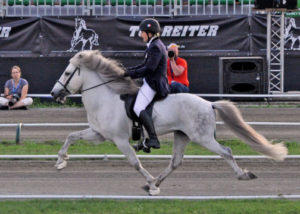Researchers at the Leibniz Institute for Zoo and Wildlife Research in Berlin, Germany, surmise that gaited horses developed from a mutation that appeared in English horses by the 9th century A. D. During this time, the Vikings made frequent raids on Yorkshire in northern England. It is possible that the Vikings stole comfortable gaited horses from the English and transported the horses to Iceland to add to the herds that were already there.
The “gaited” gene—a mutation in the DMRT3 gene—was not found in horses on the Eurasian landmass before 900 A. D., but has been found earlier in the remains of English horses. Probably the Vikings began breeding selectively after they brought the gaited specimens to Iceland; the number of horses in Iceland bearing the mutation increased greatly during the next two centuries, and, after that, the gaited mutation spread throughout the world. 
Tracking the dispersal over time of equine traits is rewarding: remains of equines are numerous and usable DNA can be found in fossilized bones that are thousands of years old.
[Research published in Current Biology, 2016:26 (15); summary in ScienceDaily.com]
[Photo of a competitor at the World Championship for Icelandic Horses, taken by Monika Reissman]





